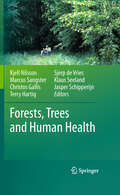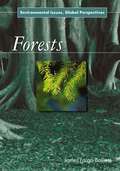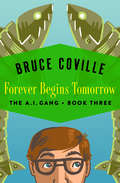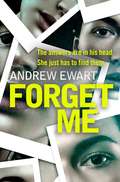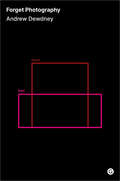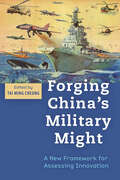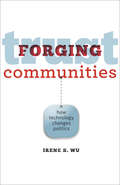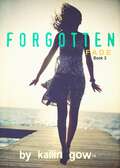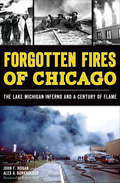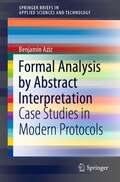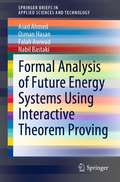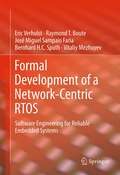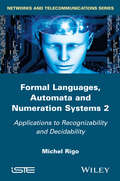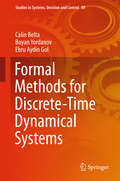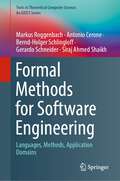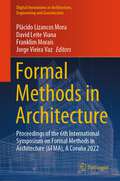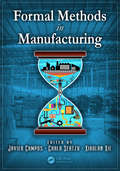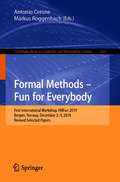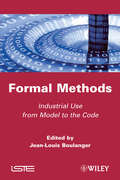- Table View
- List View
Forests, Trees and Human Health
by Kjell Nilsson Terry Hartig Marcus Sangster Klaus Seeland Sjerp De Vries Jasper Schipperijn Christos GallisThe link between modern lifestyles and increasing levels of chronic heart disease, obesity, stress and poor mental health is a concern across the world. The cost of dealing with these conditions places a large burden on national public health budgets so that policymakers are increasingly looking at prevention as a cost-effective alternative to medical treatment. Attention is turning towards interactions between the environment and lifestyles. Exploring the relationships between health, natural environments in general, and forests in particular, this groundbreaking book is the outcome of the European Union's COST Action E39 'Forests, Trees and Human Health and Wellbeing', and draws together work carried out over four years by scientists from 25 countries working in the fields of forestry, health, environment and social sciences. While the focus is primarily on health priorities defined within Europe, this volume explicitly draws also on research from North America.
Forests: Environmental Issues, Global Perspectives (Environmental Issues, Global Perspectives Ser.)
by James Fargo BalliettForests are considered the lungs of the planet, as they consume and store carbon dioxide and produce oxygen. These biomes, defined as ecological communities dominated by long-lived woody vegetation, historically have provided an economic foundation for growing nations, supplying wood for buildings, firewood for fuel, and land for expanding cities and farms. For centuries, industrial nations in Europe and the United States have relied on large tracts of forestland for economic prosperity. The research presented in this book reveals that population pressures are causing considerable environmental distress in even the most remote forest areas. Three detailed case studies are presented. The first provides an assessment of illegal logging deep in South America’s Amazon rain forest, a region closely tied to food and product demands thousands of miles away. The second examines the effect of increased hunting in Central Africa’s Congo forest, which threatens wildlife, especially mammal species with slower reproductive cycles. Finally the third describes encroachment on old-growth tropical forests on the Southern Pacific island of Borneo, which today is better managed thanks to the collective planning and conservation efforts of the governments of Brunei, Indonesia, and Malaysia.
Forever Begins Tomorrow (The A.I. Gang #3)
by Bruce CovilleCan the gang save the world before it's too late? When it comes down to adults versus kids, who's going to believe the kids--even if they are geniuses? That's the problem the A.I. Gang faces when they find themselves locked in a death-defying final showdown with the mysterious Black Glove. Contending with danger and disgrace, the team fights on with only the help of a mysterious friend to give them an occasional clue. But these six kids just can't give up. Would you, if you were the only thing standing in the way of a high-tech horror that could spell destruction for the entire planet? This ebook features an illustrated personal history of Bruce Coville including rare images from the author's collection.
Forever Chemicals: Environmental, Economic, and Social Equity Concerns with PFAS in the Environment (Environmental and Occupational Health Series)
by David M. Kempisty LeeAnn RaczForever Chemicals: Environmental, Economic, and Social Equity Concerns with PFAS in the Environment provides the reader with an understanding of the complex and interwoven issues associated with per- and polyfluorinated substances (PFAS) in our environment. The chapters provide in-depth perspective into various issues, including health, regulation, detection, clean-up strategies and technologies, and more. Taken together or as the reader’s interests lead them, the variety of topics covered in the book present a balanced perspective on this complex topic. It will address the current state of PFAS and where indicators are pointing for future developments. The book is also a deeper investigation of the regulatory challenges, analytical hurdles, and toxicological progress to date for the suite of PFAS chemicals. Features Explains the trends that will affect future policy and regulatory decisions Looks holistically at 4000+ PFAS chemicals Includes PFAS risk assessments at contaminated sites and biomonitoring insights Provides in-depth discussions on remediation technologies Illustrates quality and diversified content Provides a balanced perspective on this complex topic
Forever Young: A Life of Adventure in Air and Space
by John W YoungHe walked on the Moon. He flew six space missions in three different programs--more than any other human. He served with NASA for more than four decades. His peers called him the "astronaut's astronaut."Enthusiasts of space exploration have long waited for John Young to tell the story of his two Gemini flights, his two Apollo missions, the first-ever Space Shuttle flight, and the first Spacelab mission. Forever Young delivers all that and more: Young's personal journey from engineering graduate to fighter pilot, to test pilot, to astronaut, to high NASA official, to clear-headed predictor of the fate of Planet Earth.Young, with the assistance of internationally distinguished aerospace historian James Hansen, recounts the great episodes of his amazing flying career in fascinating detail and with wry humor. He portrays astronauts as ordinary human beings and NASA as an institution with the same ups and downs as other major bureaucracies. He frankly discusses the risks of space travel, including what went wrong with the Challenger and Columbia shuttles. Forever Young is one of the last memoirs produced by an early American astronaut. It is the first memoir written by a chief of the NASA astronaut corps. Young's experiences and candor make this book indispensable to everyone interested in the U.S. space program.
Forged: An Altered Series Prequel (Altered)
by Jennifer RushBefore Anna and Sam, there was Dani and Sam.There's one rule that all Branch operatives must live by: No attachments. When Dani O'Brien entered the Branch, she planned to trade her freedom so that her family could have a better life. But joining up with the mysterious organization is more than she bargained for. Branch head Connor watches over her closely--too closely. The training is brutal, the experiments are secret, and the missions promise to be anything but ordinary. The only thing getting Dani through each day is the hope that she'll run into Sam--a young man, about her age, who wears the world on his shoulders.Find out how it all began in this short-story prequel to Jennifer Rush's thrilling and suspenseful Altered series.
Forget Me: A gripping, thought-provoking and emotional speculative thriller
by Andrew EwartOriginal and intriguing - C.J. TudorKept me gripped to the last page - Sarah J. Harris The answers are in his head. She just has to find them. A smart high-concept thriller for fans of Before I Go To Sleep by SJ Watson, The Seven Deaths of Evelyn Hardcastle by Stuart Turton, and Hollywood blockbuster Inception, from the ITV Be A Bestseller finalist.Your partner doesn't remember anything: how you met, your first kiss, not even your wedding day. An experimental treatment promises to recover the memories they lost. But some memories are better off hidden. How far would you go to bring back the one you love? And what if the truth hurts more than the secrets.
Forget Photography
by Andrew DewdneyWhy we must forget photography and reject the frame of reality it prescribes and delineates.The central paradox this book explores is that at the moment of photography's replacement by the algorithm and data flow, photographic cultures proliferate as never before. The afterlife of photography, residual as it may technically be, maintains a powerful cultural and representational hold on reality, which is important to understand in relationship to the new conditions. Forgetting photography is a strategy to reveal the redundant historicity of the photographic constellation and the cultural immobility of its epicenter. It attempts to liberate the image from these historic shackles, forged by art history and photographic theory. More important, perhaps, forgetting photography also entails rejecting the frame of reality it prescribes and delineates, and in doing so opens up other relationships between bodies, times, events, materials, memory, representation and the image. Forgetting photography attempts to develop a systematic method for revealing the limits and prescriptions of thinking with photography, which no amount of revisionism of post-photographic theory can get beyond. The world urgently needs to unthink photography and go beyond it in order to understand the present constitution of the image as well as the reality or world it shows. Forgetting photography will require a different way of organizing knowledge about the visual in culture that involves crossing different knowledges of visual culture, technologies, and mediums. It will also involve thinking differently about routine and creative labor and its knowledge practices within the institutions and organization of visual reproduction.
Forging China's Military Might: A New Framework for Assessing Innovation
by Tai Ming Cheung“His collection of nine essays offers a comprehensive and insightful assessment of the Chinese defense science and technology (S&T).” —Pacific AffairsAmong the most important issues in international security today are the nature and the global implications of China’s emergence as a world-class defense technology power. Since the beginning of the twenty-first century, the Chinese defense industry has reinvented itself by emphasizing technological innovation and technology. This reinvention and its potential effects, both positive and negative, are attracting global scrutiny. Drawing insights from a range of disciplines, including history, social science, business, and strategic studies, Tai Ming Cheung and the contributors to Forging China’s Military Might develop an analytical framework to evaluate the nature, dimensions, and spectrum of Chinese innovation in the military and broader defense spheres.Forging China’s Military Might provides an overview of the current state of the Chinese defense industry and then focuses on subjects critical to understanding short- and long-term developments, including the relationship among defense contractors, regulators, and end-users; civil-military integration; China’s defense innovation system; and China’s place in the global defense economy. Case studies look in detail at the Chinese space and missile industry.“Constitutes high-quality, cutting-edge research on China’s defense industries. It should enjoy broad appeal—among academics, policy makers, security analysts, and business people in countries around the world.” —Andrew Scobell, RAND Corporation“Forging China’s Military Might belongs in any political science shelf interested in China’s issues and international security and considers the nature of China’s emergence as a world power.” —Midwest Book Review
Forging Trust Communities: How Technology Changes Politics
by Irene S. WuTwenty historical case studies reveal how communication technology allows people to trust one another while mobilizing around a shared cause.Bloggers in India used social media and wikis to broadcast news and bring humanitarian aid to tsunami victims in South Asia. Terrorist groups like ISIS pour out messages and recruit new members on websites. The Internet is the new public square, bringing to politics a platform on which to create community at both the grassroots and bureaucratic level. Drawing on historical and contemporary case studies from more than ten countries, Irene S. Wu’s Forging Trust Communities argues that the Internet, and the technologies that predate it, catalyze political change by creating new opportunities for cooperation. The Internet does not simply enable faster and easier communication, but makes it possible for people around the world to interact closely, reciprocate favors, and build trust. The information and ideas exchanged by members of these cooperative communities become key sources of political power akin to military might and economic strength. Wu illustrates the rich world history of citizens and leaders exercising political power through communications technology. People in nineteenth-century China, for example, used the telegraph and newspapers to mobilize against the emperor. In 1970, Taiwanese cable television gave voice to a political opposition demanding democracy. Both Qatar (in the 1990s) and Great Britain (in the 1930s) relied on public broadcasters to enhance their influence abroad. Additional case studies from Brazil, Egypt, the United States, Russia, India, the Philippines, and Tunisia reveal how various technologies function to create new political energy, enabling activists to challenge institutions while allowing governments to increase their power at home and abroad. Forging Trust Communities demonstrates that the way people receive and share information through network communities reveals as much about their political identity as their socioeconomic class, ethnicity, or religion. Scholars and students in political science, public administration, international studies, sociology, and the history of science and technology will find this to be an insightful and indispensable work.
Forgotten (FADE Series #3)
by Kailin GowWinner of the IBPA Benjamin Franklin Silver Award! PRAISE FOR FADE: "Kailin Gow does her readers justice with this thrilling and mind boggling series. Fade introduces readers to a concept that is out of this world." - Woven Myst Young Adult Magazine DESCRIPTION for FORGOTTEN (FADE BOOK 3): A love that can never be forgotten... The truth about Celestra Caine comes back in the most shocking way. Everyone knew Celestra Caine was dangerous, but they didn't know she was THAT dangerous... As Celestra's memories begin returning to her after being Faded, and her identity is revealed, she learns the fate of the world really is in her hands, and that she, the mysterious and sexy fader Jack, and her handsome ex-boyfriend Gray are more connected to each other than she ever imagined. In this dystopian ya thriller, where nothing is what it seems, sometimes love can be strong enough to withstand time and space and never be forgotten. Kailin Gow's FADE Series(TM) FADE Falling (FADE #2) Forgotten (FADE #3) Fever (FADE #4)
Forgotten Agricultural Heritage: Reconnecting food systems and sustainable development (Earthscan Food and Agriculture)
by Miguel A. Altieri Parviz KoohafkanContemporary agriculture is often criticized for its industrial scale, adverse effects on nutrition, rural employment and the environment, and its disconnectedness from nature and culture. Yet there are many examples of traditional smaller scale systems that have survived the test of time and provide more sustainable solutions while still maintaining food security in an era of climate change. This book provides a unique compilation of this forgotten agricultural heritage and is based on objective scientific evaluation and evidence of the value of these systems for present and future generations. The authors refer to many of these systems as Globally Important Agricultural Heritage Systems (GIAHS) and show how they are related to the concepts of heritage and the World Heritage Convention. They demonstrate how GIAHS based on family farms, traditional indigenous knowledge and agroecological principles can contribute to food and nutrition security and the maintenance of agro-biodiversity and environmental resilience, as well as sustain local cultures, economies and societies. Two substantial chapters are devoted to descriptions and assessments of some 50 examples of designated and potential GIAHS from around the world, including rice-fish culture in China, mountain terrace systems in Asia, coffee agroforestry in Latin America, irrigation systems and land and water management in Iran and India, pastoralism in East Africa, and the dehesa agrosilvopastoral system of Spain and Portugal. The book concludes by providing policy and technical solutions for sustainable agriculture and rural development through the enhancement of these systems.
Forgotten Fires of Chicago: The Lake Michigan Inferno and a Century of Flame (Disaster Ser.)
by John F. Hogan Alex A. BurkholderA historical journey through the city&’s catastrophic fires, and the stories of the heroes who fought them. Chicago&’s war against cinder, flame, and smoke did not end with the Great Fire of 1871. In 1909, fire ripped through the dynamite room of a staging facility a mile and half off the Lake Michigan shoreline, transforming the pipe-laying operation into a raging inferno. During the World&’s Columbian Exposition, thousands of fairgoers watched in horror as twelve firefighters were trapped in a blazing ice warehouse. An opera-goer left a smoking bomb under his seat at the Auditorium Theater in 1917. And the newly invented smoke ejector arrived too late to save firemen and laborers cut off in a sewer in 1931. Join John F. Hogan and Alex A. Burkholder for the history of these forgotten fires—and those who responded to them. &“A must-read not only for first responders but also all history buffs, especially those interested in Chicago history.&” —Robert Hoff, retired fire commissioner, Chicago Fire Department, from the foreword
Formability
by Wilko C. Emmens- Overview of materials and treatment aspects of manufacturability of sheet metal - Written by an industrial expert turned scientist - Concentrates on the formability of sheet metal, one of the fundamental form material is used in metalworking
Formal Analysis by Abstract Interpretation: Case Studies in Modern Protocols (SpringerBriefs in Applied Sciences and Technology)
by Benjamin AzizThe book provides a gentle introduction and definition of the denotational-based abstract interpretation method. The book demonstrates how the above method of formal analysis can be used, not only to address the security of systems, but other more general and interesting properties related to the testing, mutating and semantic ambiguity resolution of protocols. The book presents three case studies, all related to current complex protocols and standards used in industry, particularly in the context of IoT and Industry 4.0.
Formal Analysis of Future Energy Systems Using Interactive Theorem Proving (SpringerBriefs in Applied Sciences and Technology)
by Osman Hasan Asad Ahmed Falah Awwad Nabil BastakiThis book describes an accurate analysis technique for energy systems based on formal methods—computer-based mathematical logic techniques for the specification, validation, and verification of the systems. Correctness and accuracy of the financial, operational, and implementation analysis are of the paramount importance for the materialization of the future energy systems, such as smart grids, to achieve the objectives of cost-effectiveness, efficiency, and quality-of-service. In this regard, the book develops formal theories of microeconomics, asymptotic, and stability to support the formal analysis of generation and distribution cost, smart operations, and processing of energy in a smart grid. These formal theories are also employed to formally verify the cost and utility modeling for: Energy generation and distribution;Asymptotic bounds for online scheduling algorithms for plug-in electric vehicles; andStability of the power converters for wind turbines. The proposed approach results in mechanized proofs for the specification, validation, and verification of corresponding smart grid problems. The formal mathematical theories developed can be applied to the formal analysis of several other hardware and software systems as well, making this book of interest to researchers and practicing engineers in a variety of power electronic fields.
Formal Development of a Network-Centric RTOS
by Eric Verhulst José Miguel Faria Raymond T. Boute Vitaliy Mezhuyev Bernhard H.C. SputhMany systems, devices and appliances used routinely in everyday life, ranging from cell phones to cars, contain significant amounts of software that is not directly visible to the user and is therefore called "embedded". For coordinating the various software components and allowing them to communicate with each other, support software is needed, called an operating system (OS). Because embedded software must function in real time (RT), a RTOS is needed. This book describes a formally developed, network-centric Real-Time Operating System, OpenComRTOS. One of the first in its kind, OpenComRTOS was originally developed to verify the usefulness of formal methods in the context of embedded software engineering. Using the formal methods described in this book produces results that are more reliable while delivering higher performance. The result is a unique real-time concurrent programming system that supports heterogeneous systems with just 5 Kbytes/node. It is compatible with safety related engineering standards, such as IEC61508.
Formal Languages, Automata and Numeration Systems, Volume 2
by Michel RigoThe interplay between words, computability, algebra and arithmetic has now proved its relevance and fruitfulness. Indeed, the cross-fertilization between formal logic and finite automata (such as that initiated by J.R. Büchi) or between combinatorics on words and number theory has paved the way to recent dramatic developments, for example, the transcendence results for the real numbers having a "simple" binary expansion, by B. Adamczewski and Y. Bugeaud. This book is at the heart of this interplay through a unified exposition. Objects are considered with a perspective that comes both from theoretical computer science and mathematics. Theoretical computer science offers here topics such as decision problems and recognizability issues, whereas mathematics offers concepts such as discrete dynamical systems.The main goal is to give a quick access, for students and researchers in mathematics or computer science, to actual research topics at the intersection between automata and formal language theory, number theory and combinatorics on words. The second of two volumes on this subject, this book covers regular languages, numeration systems, formal methods applied to decidability issues about infinite words and sets of numbers.
Formal Methods for Discrete-Time Dynamical Systems
by Calin Belta Boyan Yordanov Ebru Aydin GolThis book bridges fundamental gaps between control theory and formal methods. Although it focuses on discrete-time linear and piecewise affine systems, it also provides general frameworks for abstraction, analysis, and control of more general models. The book is self-contained, and while some mathematical knowledge is necessary, readers are not expected to have a background in formal methods or control theory. It rigorously defines concepts from formal methods, such as transition systems, temporal logics, model checking and synthesis. It then links these to the infinite state dynamical systems through abstractions that are intuitive and only require basic convex-analysis and control-theory terminology, which is provided in the appendix. Several examples and illustrations help readers understand and visualize the concepts introduced throughout the book.
Formal Methods for Software Engineering: Languages, Methods, Application Domains (Texts in Theoretical Computer Science. An EATCS Series)
by Antonio Cerone Siraj Ahmed Shaikh Markus Roggenbach Gerardo Schneider Bernd-Holger SchlingloffSoftware programs are formal entities with precise meanings independent of their programmers, so the transition from ideas to programs necessarily involves a formalisation at some point. The first part of this graduate-level introduction to formal methods develops an understanding of what constitutes formal methods and what their place is in Software Engineering. It also introduces logics as languages to describe reasoning and the process algebra CSP as a language to represent behaviours. The second part offers specification and testing methods for formal development of software, based on the modelling languages CASL and UML. The third part takes the reader into the application domains of normative documents, human machine interfaces, and security. Use of notations and formalisms is uniform throughout the book. Topics and features: Explains foundations, and introduces specification, verification, and testing methods Explores various application domains Presents realistic and practical examples, illustrating concepts Brings together contributions from highly experienced educators and researchers Offers modelling and analysis methods for formal development of software Suitable for graduate and undergraduate courses in software engineering, this uniquely practical textbook will also be of value to students in informatics, as well as to scientists and practical engineers, who want to learn about or work more effectively with formal theories and methods. Markus Roggenbach is a Professor in the Dept. of Computer Science of Swansea University. Antonio Cerone is an Associate Professor in the Dept. of Computer Science of Nazarbayev University, Nur-Sultan. Bernd-Holger Schlingloff is a Professor in the Institut für Informatik of Humboldt-Universität zu Berlin. Gerardo Schneider is a Professor in the Dept. of Computer Science and Engineering of University of Gothenburg. Siraj Ahmed Shaikh is a Professor in the Institute for Future Transport and Cities of Coventry University.
Formal Methods in Architecture: Proceedings of the 5th International Symposium on Formal Methods in Architecture (5FMA), Lisbon 2020 (Advances in Science, Technology & Innovation)
by Sara Eloy David Leite Viana Franklim Morais Jorge Vieira VazThis edited book gathers research studies presented at the 5th International Symposium on Formal Methods in Architecture (5FMA), Lisbon 2020. Studies focus on the use of methodologies, especially those that have witnessed recent developments, that stem from the mathematical and computer sciences and are developed in a collaborative way with architecture and related fields. This book constitutes a contribution to the debate and to the introduction of new methodologies and tools in the mentioned fields that derive from the application of formal methods in the creation of new explicit languages for problem-solving in architecture and urbanism. It adds valuable insight into the development of new practices solving identified societal problems and promoting the digital transformation of institutions in the mentioned fields. The primary audience of this book will be from the fields of architecture, urban planning, civil engineering, AEC, landscape design, computer sciences and mathematics, both academicians and professionals.
Formal Methods in Architecture: Proceedings of the 6th International Symposium on Formal Methods in Architecture (6FMA), A Coruña 2022 (Digital Innovations in Architecture, Engineering and Construction)
by David Leite Viana Franklim Morais Jorge Vieira Vaz Plácido Lizancos MoraThis book comprises the select proceedings of the 6th International Symposium on Formal Methods in Architecture (6FMA), A Coruña 2022. The contents focus on the use of methodologies, especially those that have witnessed recent developments stemming from mathematical and computer sciences and are developed in a collaborative way with architecture and related fields. This book constitutes a contribution to the debate and to the introduction of new methodologies and tools in the mentioned fields that derive from the application of formal methods in the creation of new explicit languages for problem-solving in architecture and urbanism. Some of the themes in the book are CAD and BIM, mixed realities, photogrammetry and 3D scan, architectural design automation, urban and building performance analysis, SCAVA-space configuration, accessibility and visibility analysis. This book proves a valuable resource for those in academia and industry.
Formal Methods in Manufacturing (Industrial Information Technology)
by Javier Campos Xiaolan Xie Carla SeatzuIllustrated with real-life manufacturing examples, Formal Methods in Manufacturing provides state-of-the-art solutions to common problems in manufacturing systems. Assuming some knowledge of discrete event systems theory, the book first delivers a detailed introduction to the most important formalisms used for the modeling, analysis, and control of manufacturing systems (including Petri nets, automata, and max-plus algebra), explaining the advantages of each formal method. It then employs the different formalisms to solve specific problems taken from today’s industrial world, such as modeling and simulation, supervisory control (including deadlock prevention) in a distributed and/or decentralized environment, performance evaluation (including scheduling and optimization), fault diagnosis and diagnosability analysis, and reconfiguration. Containing chapters written by leading experts in their respective fields, Formal Methods in Manufacturing helps researchers and application engineers handle fundamental principles and deal with typical quality goals in the design and operation of manufacturing systems.
Formal Methods – Fun for Everybody: First International Workshop, FMFun 2019, Bergen, Norway, December 2–3, 2019, Revised Selected Papers (Communications in Computer and Information Science #1301)
by Antonio Cerone Markus RoggenbachThis volume constitutes the post-workshop proceedings of the First International Workshop on Formal Methods – Fun for Everybody, FMFun 2019, held in Bergen, Norway, in December 2019.The 7 revised full papers and 2 revised short papers presented in this volume were carefully reviewed and selected from 15 submissions. A white paper and two keynote papers are also included. The papers explore ways of utilizing the pathway to transforming and spreading formal methods. The vision of this workshop series is that formal methods ought to be taught in such a way that every student can have fun with it.
Formal Methods: Industrial Use from Model to the Code (Wiley-iste Ser. #692)
by Jean-Louis BoulangerAlthough formal analysis programming techniques may be quite old, the introduction of formal methods only dates from the 1980s. These techniques enable us to analyze the behavior of a software application, described in a programming language. It took until the end of the 1990s before formal methods or the B method could be implemented in industrial applications or be usable in an industrial setting. Current literature only gives students and researchers very general overviews of formal methods. The purpose of this book is to present feedback from experience on the use of “formal methods” (such as proof and model-checking) in industrial examples within the transportation domain. This book is based on the experience of people who are currently involved in the creation and evaluation of safety critical system software. The involvement of people from within the industry allows us to avoid the usual problems of confidentiality which could arise and thus enables us to supply new useful information (photos, architecture plans, real examples, etc.). Topics covered by the chapters of this book include SAET-METEOR, the B method and B tools, model-based design using Simulink, the Simulink design verifier proof tool, the implementation and applications of SCADE (Safety Critical Application Development Environment), GATeL: A V&V Platform for SCADE models and ControlBuild. Contents 1. From Classic Languages to Formal Methods, Jean-Louis Boulanger. 2. Formal Method in the Railway Sector the First Complex Application: SAET-METEOR, Jean-Louis Boulanger. 3. The B Method and B Tools, Jean-Louis Boulanger. 4. Model-Based Design Using Simulink – Modeling, Code Generation, Verification, and Validation, Mirko Conrad and Pieter J. Mosterman. 5. Proving Global Properties with the Aid of the SIMULINK DESIGN VERIFIER Proof Tool, Véronique Delebarre and Jean-Frédéric Etienne. 6. SCADE: Implementation and Applications, Jean-Louis Camus. 7. GATeL: A V&V Platform for SCADE Models, Bruno Marre, Benjamin Bianc, Patricia Mouy and Christophe Junke. 8. ControlBuild, a Development Framework for Control Engineering, Franck Corbier. 9. Conclusion, Jean-Louis Boulanger.
